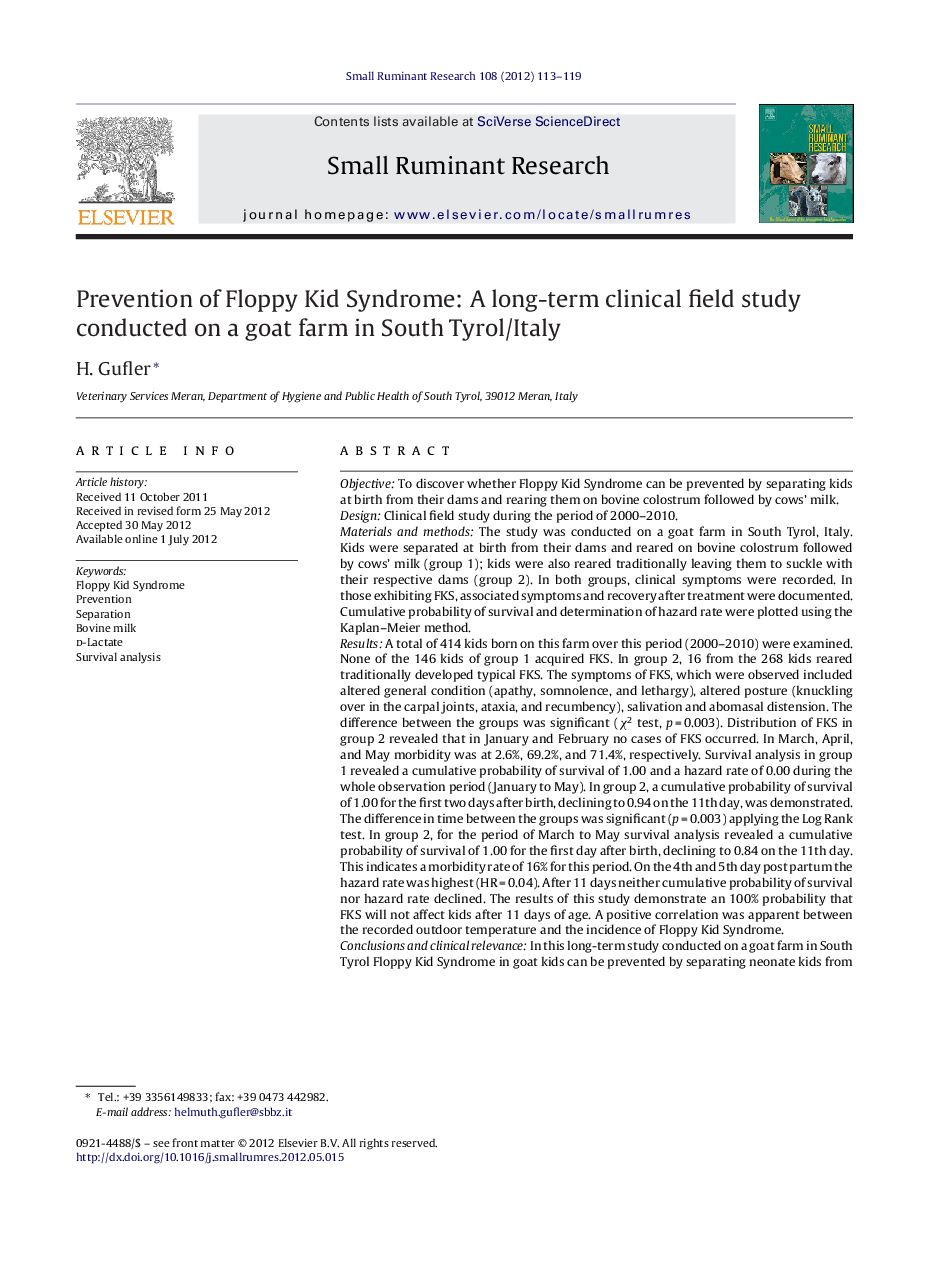| کد مقاله | کد نشریه | سال انتشار | مقاله انگلیسی | نسخه تمام متن |
|---|---|---|---|---|
| 5796242 | 1554384 | 2012 | 7 صفحه PDF | دانلود رایگان |

ObjectiveTo discover whether Floppy Kid Syndrome can be prevented by separating kids at birth from their dams and rearing them on bovine colostrum followed by cows' milk.DesignClinical field study during the period of 2000-2010.Materials and methodsThe study was conducted on a goat farm in South Tyrol, Italy. Kids were separated at birth from their dams and reared on bovine colostrum followed by cows' milk (group 1); kids were also reared traditionally leaving them to suckle with their respective dams (group 2). In both groups, clinical symptoms were recorded. In those exhibiting FKS, associated symptoms and recovery after treatment were documented. Cumulative probability of survival and determination of hazard rate were plotted using the Kaplan-Meier method.ResultsA total of 414 kids born on this farm over this period (2000-2010) were examined. None of the 146 kids of group 1 acquired FKS. In group 2, 16 from the 268 kids reared traditionally developed typical FKS. The symptoms of FKS, which were observed included altered general condition (apathy, somnolence, and lethargy), altered posture (knuckling over in the carpal joints, ataxia, and recumbency), salivation and abomasal distension. The difference between the groups was significant (Ï2 test, p = 0.003). Distribution of FKS in group 2 revealed that in January and February no cases of FKS occurred. In March, April, and May morbidity was at 2.6%, 69.2%, and 71.4%, respectively. Survival analysis in group 1 revealed a cumulative probability of survival of 1.00 and a hazard rate of 0.00 during the whole observation period (January to May). In group 2, a cumulative probability of survival of 1.00 for the first two days after birth, declining to 0.94 on the 11th day, was demonstrated. The difference in time between the groups was significant (p = 0.003) applying the Log Rank test. In group 2, for the period of March to May survival analysis revealed a cumulative probability of survival of 1.00 for the first day after birth, declining to 0.84 on the 11th day. This indicates a morbidity rate of 16% for this period. On the 4th and 5th day post partum the hazard rate was highest (HR = 0.04). After 11 days neither cumulative probability of survival nor hazard rate declined. The results of this study demonstrate an 100% probability that FKS will not affect kids after 11 days of age. A positive correlation was apparent between the recorded outdoor temperature and the incidence of Floppy Kid Syndrome.Conclusions and clinical relevanceIn this long-term study conducted on a goat farm in South Tyrol Floppy Kid Syndrome in goat kids can be prevented by separating neonate kids from the dams, and rearing the kids with bovine colostrum/milk. The important factor seems to be the separation of new born kids from adults, thus preventing exposure of kids via sucking/licking to the bacterial agent causing d-lactic acidosis, originating from the adult goats or their immediate environment. Greatest susceptibility for Floppy Kid Syndrome is in the period from March to May between the 3rd and 6th day post partum.
Journal: Small Ruminant Research - Volume 108, Issues 1â3, November 2012, Pages 113-119